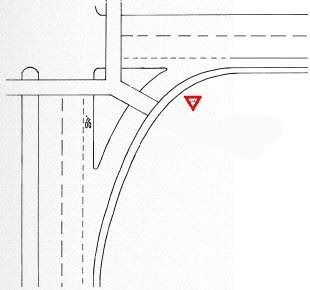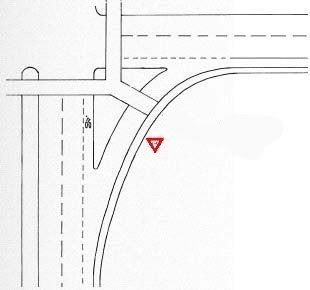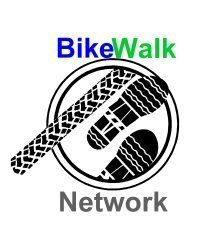Moving the Yield Posts
I've noticed a trend in intersection design in the last few years. Slip Lanes.
When you come to an intersection and the right lane peels away into a turn lane that avoids the light at the intersection. Yeah, that's a slip lane.
The good things about slip lanes for cars: they usually only have a yield sign so if you're turning right you don't necessarily have to stop.
The bad thing for cars: you can get a real crick in your neck trying to watch for traffic because the slip lane frequently gets you turned so the traffic you are merging into is over your right shoulder.
For pedestrians the upside is that after you cross that first lane of traffic, you get a little island where you can stop out of traffic. So it cuts down the very large space of roadway you have to cross all at once. Usually you don't get a signal to cross the slip lane.
The downside for pedestrians is that a slip lane is a place where motorists are not looking for pedestrians and they don't have a good understanding of their responsibilities.
Far smarter people with lots of initials after their names regularly debate the turning radius and angle of incidence of slip lanes and all of the engineering. I have one simple request: move the yield sign up.
Traffic engineers, unfortunately, seem to treat signage as an afterthought. On this one, my litigious side kicks in. There is an obscure section of Florida Law (I assume it is part of the UTC) that makes a big difference from a legal standpoint.
That bold section is the important part and the key in it is "after driving past a yield sign without stopping". So look at two scenarios where a driver hits a pedestrian in the crosswalk in a slip lane where a yield sign is present. If the crosswalk is before the yield sign, there is discussion and debate about whether the pedestrian walked in front of the car, allowed the motorist enough time to react, etc. If the yield sign comes before the crosswalk, none of that has to happen. The driver is liable. Period.
In either case the pedestrian is the victim. There really should be no time wasted discussing right of way issues. This is the responsibility that comes with the convenience of the slip lane: drivers have to be more vigilant and attentive. Drivers love to pretend that what happens on sidewalks is not their problem. They'll watch for cars approaching an intersection and react. They won't look for pedestrians approaching an intersection. They only accomodate pedestrians who are in the road already. And not always even them.
In a perfect world, the pedestrian has some self-preservation and won't step out in front of a car that can't slow down. Likewise, the driver is watching sidewalks for approaching pedestrians and prepares to slow, stop, or avoid them if they unexpectedly go into the road. Unfortunately, drivers feel the power too much. They just don't have enough to lose and they tend not to do their part to avoid crashes. The attitudes of drivers can be very domineering. Roads are for cars. Screw the people.
So this small change, moving the yield sign up ahead of the crosswalk gives pedestrians some added legal protection. It puts a little more responsibility on the drivers. In terms of real safety, it won't prevent any crashes. That is probably why traffic engineers ignore the placement of yield signs and tend to focus on putting them where they are in view while slip-lane drivers are preparing to enter the new roadway in the new direction.
When you come to an intersection and the right lane peels away into a turn lane that avoids the light at the intersection. Yeah, that's a slip lane.
The good things about slip lanes for cars: they usually only have a yield sign so if you're turning right you don't necessarily have to stop.
The bad thing for cars: you can get a real crick in your neck trying to watch for traffic because the slip lane frequently gets you turned so the traffic you are merging into is over your right shoulder.
For pedestrians the upside is that after you cross that first lane of traffic, you get a little island where you can stop out of traffic. So it cuts down the very large space of roadway you have to cross all at once. Usually you don't get a signal to cross the slip lane.
The downside for pedestrians is that a slip lane is a place where motorists are not looking for pedestrians and they don't have a good understanding of their responsibilities.
Far smarter people with lots of initials after their names regularly debate the turning radius and angle of incidence of slip lanes and all of the engineering. I have one simple request: move the yield sign up.
Traffic engineers, unfortunately, seem to treat signage as an afterthought. On this one, my litigious side kicks in. There is an obscure section of Florida Law (I assume it is part of the UTC) that makes a big difference from a legal standpoint.
316.123 Vehicle entering stop or yield intersection.--
(3) The driver of a vehicle approaching a yield sign shall, in obedience to such sign, slow down to a speed reasonable for the existing conditions and, if required for safety to stop, shall stop before entering the crosswalk on the near side of the intersection, or, if none, then at the point nearest the intersecting roadway where the driver has a view of approaching traffic on the intersecting roadway. After slowing or stopping, the driver shall yield the right-of-way to any vehicle in the intersection or approaching on another highway so closely as to constitute an immediate hazard during the time the driver is moving across or within the intersection. If such a driver is involved in a collision with a pedestrian in a crosswalk or a vehicle in the intersection, after driving past a yield sign without stopping, the collision shall be deemed prima facie evidence of the driver's failure to yield the right-of-way.
That bold section is the important part and the key in it is "after driving past a yield sign without stopping". So look at two scenarios where a driver hits a pedestrian in the crosswalk in a slip lane where a yield sign is present. If the crosswalk is before the yield sign, there is discussion and debate about whether the pedestrian walked in front of the car, allowed the motorist enough time to react, etc. If the yield sign comes before the crosswalk, none of that has to happen. The driver is liable. Period.
In either case the pedestrian is the victim. There really should be no time wasted discussing right of way issues. This is the responsibility that comes with the convenience of the slip lane: drivers have to be more vigilant and attentive. Drivers love to pretend that what happens on sidewalks is not their problem. They'll watch for cars approaching an intersection and react. They won't look for pedestrians approaching an intersection. They only accomodate pedestrians who are in the road already. And not always even them.
In a perfect world, the pedestrian has some self-preservation and won't step out in front of a car that can't slow down. Likewise, the driver is watching sidewalks for approaching pedestrians and prepares to slow, stop, or avoid them if they unexpectedly go into the road. Unfortunately, drivers feel the power too much. They just don't have enough to lose and they tend not to do their part to avoid crashes. The attitudes of drivers can be very domineering. Roads are for cars. Screw the people.
 |  |  |
So this small change, moving the yield sign up ahead of the crosswalk gives pedestrians some added legal protection. It puts a little more responsibility on the drivers. In terms of real safety, it won't prevent any crashes. That is probably why traffic engineers ignore the placement of yield signs and tend to focus on putting them where they are in view while slip-lane drivers are preparing to enter the new roadway in the new direction.


